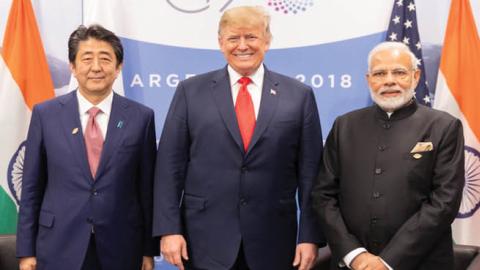The rise of China as a global power has posed numerous challenges for Japan and the United States. In the field of defense technology, China still lags behind the US, but recently China has been catching up. According to figures published by the UNESCO Institute for Statistics in July 2018, the United States leads the world in research and development investment at $476 billion, but China is now in second place at $371 billion.1 China’s R&D capabilities have advanced very rapidly, especially in the fields of Artificial Intelligence, Internet of Technologies, 3D printing, and other new technologies.
In order to maintain their technological advantage, Japan and the United States should form a partnership with another rising power in the region which has the potential to be an important collaborator: India. To achieve that goal, it is important to be familiar with the history of India’s defense technology sector. I will break that history down into three parts: the past, the present, and the future. Once we have explored the timeline of India’s defense technology sector, we can be clearer about what type of technological partnership Japan and the United States should seek with India.
The Past: A History of Catch-Up
India has tried to catch up to other great powers in the development of defense technologies.
The country has a history of independently developing and manufacturing its own weapons. In the 1960s, India developed its own fighter jet. In 1974, it had its first successful nuclear bomb test. In 1983 its first indigenous frigates were commissioned, in the 1990s it developed ballistic missiles, and in 2004 it deployed its first internally developed tanks.
Because India has been involved in, by my count, over thirty wars and conflicts since 1947, the country has had opportunities to test new military technologies in battle. However, India has lacked the means to develop and deploy new technologies in response to needs that arise in the course of military conflict. In that respect, India differs from some other countries. For example, in the Falklands War, the British needed an Airborne Early Warning (AEW) aircraft. The UK was able to develop one in eleven weeks using helicopters. Although that was not quickly enough to deploy them in the Falklands War, this illustrates that the UK has the technological sophistication to adapt pre-existing technologies to unexpected needs as they arise in combat. Unfortunately, the Indian Armed Forces lack such an ability. As a result, India has struggled with integrating new technologies into its wartime strategy and tactics, and has often been behind the curve.
The Present: Recognizing the Importance of New Technologies
Because India’s military has not benefitted from advanced technology in battle, the Indian government has not thought defense technologies to be a vital part of security. Prior to 2017, most available annual reports published by India’s Ministry of Defence, as well as other strategic documents,2 did not highlight technology as a priority.
However, official documents published since 2017 suggest a turn in India’s approach. For example, the “Joint Doctrine Indian Armed Forces,” published in 2017, clearly states that “defence technology is a strategic resource.”3 The phrasing here is important, as such words have not been written in similar documents in the past. The 2018 “Land Warfare Doctrine” made the message even clearer. Four pages of this 13-page document are written about defense technology.4 Discussion outside of the Ministry of Defence has also grown, especially after India opened its first AI-focused research institute in Mumbai in 2018.5 And though not written specifically about defense technologies, the Indian government published its “National Strategy for Artificial Intelligence” in 2018.6
Indian think tanks have also started to discuss defense technologies. Tuneer Mukherjee, a researcher at the Observer Research Foundation (ORF) in New Delhi, wrote, “The most important element of autonomous systems will be their ability to distinguish between multiple vessels simultaneously and maintain an acoustic signature database of commercial vessels.”7 In addition, Sanjiv Tomar, from the Ministry of Defence’s think tank, the Institute for Defence Studies and Analyses, observed, “3D printing is likely to alter the ways in which supply chains and logistics are maintained in defence forces... Imagine a technician in a war zone sending an e-mail along with a digital scan of an unserviceable part of an armoured fighting vehicle which then gets printed at the nearest available 3D printer and delivered to him in no time. This can possibly minimize the need of carrying and maintaining large inventories in battle zones.”8
The Future: India as a Leading Power?
During the April 2018 DefExpo in Chennai, Indian Prime Minister Narendra Modi said, “New and emerging technologies like AI and robotics will perhaps be the most important determinants of defensive and offensive capabilities for any defence force in the future. India, with its leadership in the information-technology domain, would strive to use this technology tilt to its advantage.”9 Though it is still a newcomer, India has the will to become an influential leader in defense technology development.
How Should Japan and the US Cooperate with India?
India has begun to recognize the importance of defense technology development and has been catching up with other countries in the sector. In light of India’s aspirations as well as its accomplishments, it is not only in the interests of the US and Japan, but also of India, to cooperate on joint technological development projects. If Japan and the US pursue such cooperation, they should set their expectations in light of India’s past performance. For example, they may need to plan for an extended time frame, since, in the past, India has spent a relatively long time developing weapons (10-40 years). In addition, Japan and the US should focus joint cooperation on areas that play to India’s greatest strengths. India has already achieved much in the realms of space technologies (rocket and missile) and cyber technologies. And now they are focusing on AI, which can contribute to advances in other areas, including robotics. All of these technologies are not dependent on mass production factories but on highly-skilled researchers—an area where India has an advantage. Japan and the US should also support India’s effort to create a network of high-level Indian researchers in all three countries, as such programs are a valuable resource for promoting cooperation.
India has already started to cooperate with Japan on technological research. In October 2018, Indian Prime Minister Narendra Modi and Japanese Prime Minister Shinzo Abe signed the “India-Japan Cooperation on Digital Partnership.” This cooperative agreement states: “the two nations will cooperate in areas of next generation technologies such as Artificial Intelligence (AI), and Internet of Things (IoT), etc.”10 Furthermore, in August 2018, both countries’ Ministries of Defense signed cooperative research agreements in the areas of robotics and unmanned ground vehicles (UGVs).11 It is expected that the joint development of UGVs will include AI-related research. Because India may in the future use UGVs to patrol the Indo-China border, it is understandable that China’s cooperation on this project would run counter to India’s interests. Now is the time to promote technological cooperation between Japan, America, and India, or “JAI” cooperation, which is “victory” in Hindi.
Read in Observer Research Foundation

















